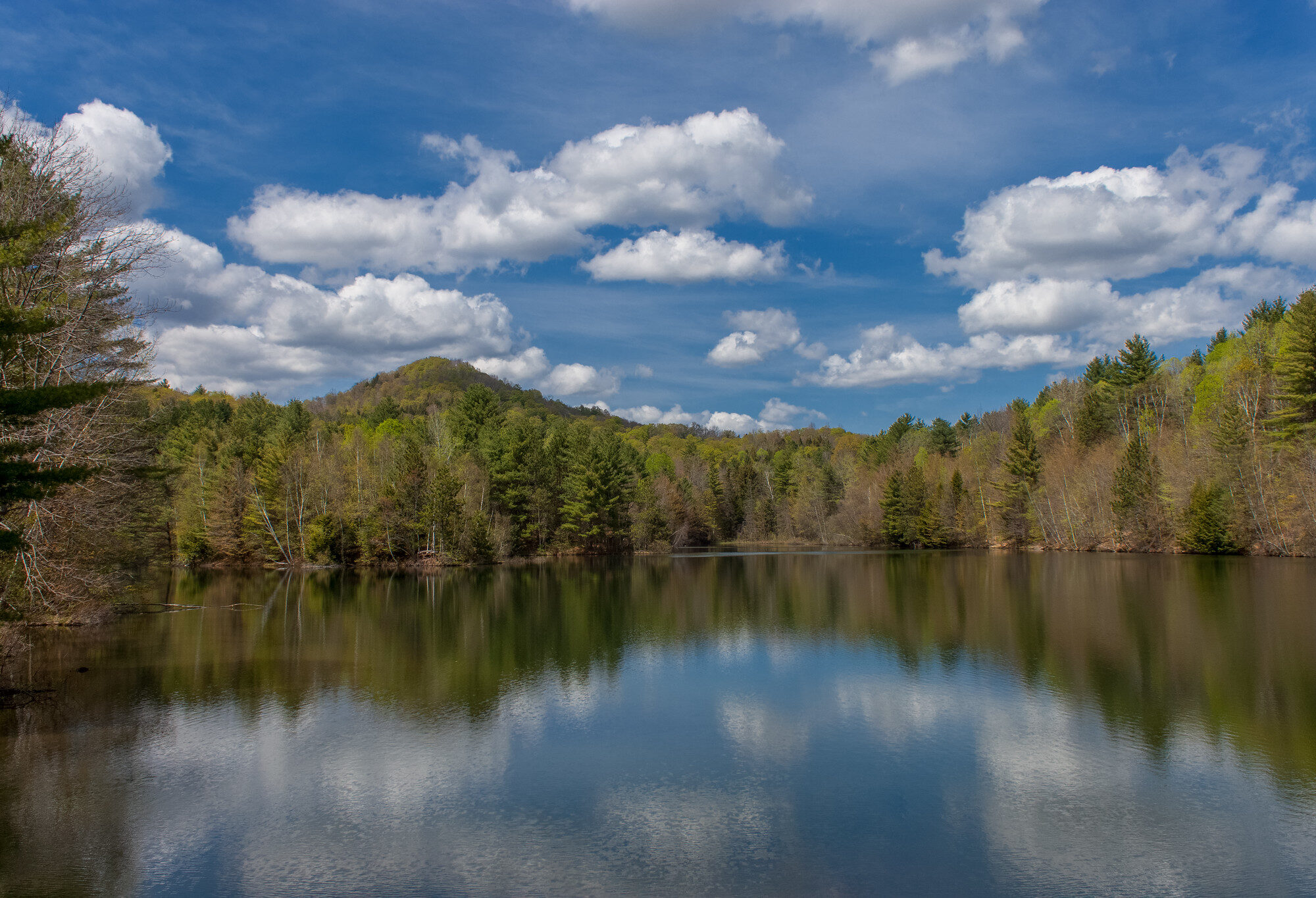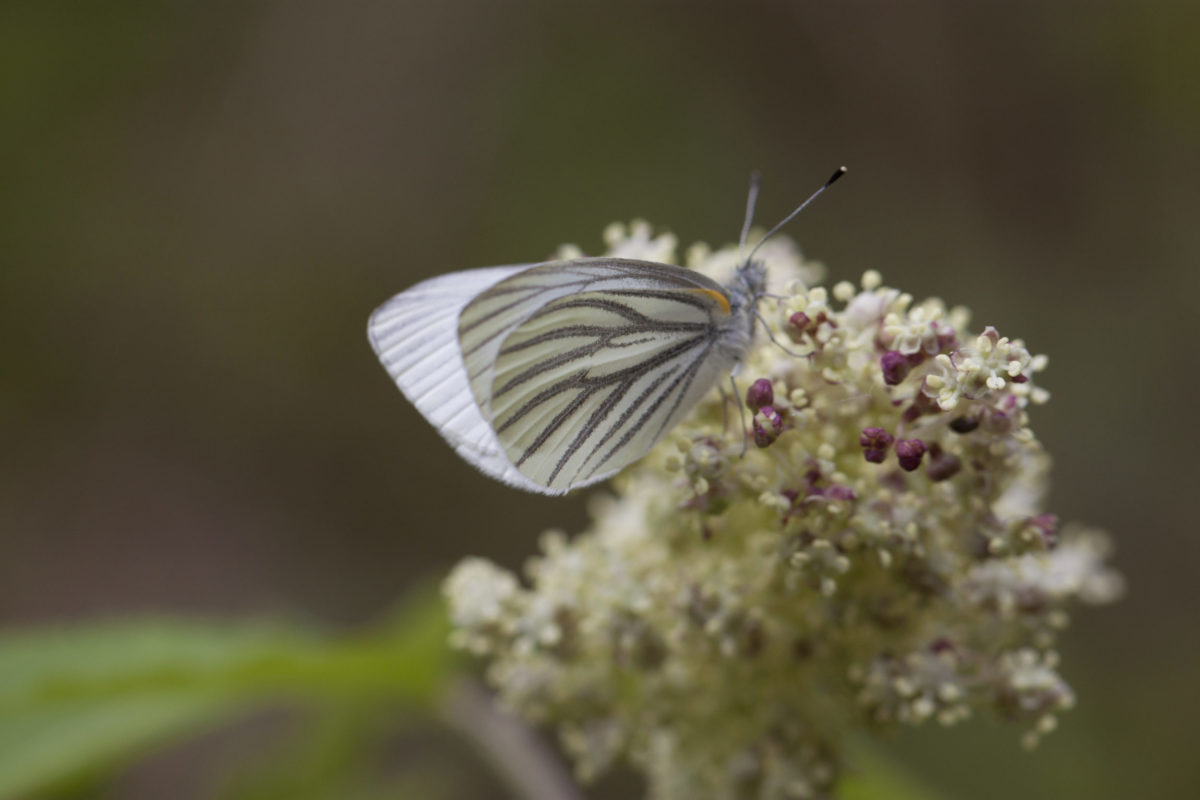

The month of May is a show-off. Birds arrive on southern winds and liven the dawn with their chorus. Trees flower, and leaves burst from long-dormant buds. As pools and lakes awaken with new life, woodland wildflowers jump out of the ground to attract the attention of butterflies. Here's your monthly guide to a month that shouts of life and rejuvenation.
By Rachel McKimmy
Hold two nickels and a dime in your hand—that’s the summer weight of a Blackpoll Warbler. This black-capped songbird returns in early May from its wintering grounds in northern South America to its breeding grounds that range from New England’s mountain forests to Alaska’s boreal forest. Blackpolls are insectivorous, large warblers (weighing 12–13 g). Their body size likely benefits them during long migratory flights and freezing nights on their breeding grounds.
When breeding season begins in June, the male (marked with a black cap or “poll”) sings his high-pitched song from treetops throughout his territory. Meanwhile, female Blackpoll Warblers are busy building their bulky, well-concealed nests low in conifers. They then lay three to five creamy buff or greenish eggs, which they alone incubate. All this stationary incubating means the females must stay well hidden from predators. Their cryptically patterned plumage may help them avoid the gaze of Sharp-shinned Hawks (Accipiter striatus), which are known to prey on both nestlings and, occasionally, attending adults.
Blackpolls are one of ten northeastern montane bird species monitored by VCE’s Mountain Birdwatch program. Thanks to years of diligent data collection, we can identify population trends, such as those published in our 2023 State of the Mountain Birds Report. This report indicates an alarming decline of Blackpoll Warblers in the areas surveyed: approximately 4.5% per year, which corresponds with a 45% overall decline between 2010 and 2023. Under most climate change scenarios, the data indicate that Blackpoll Warbler ranges will move steadily northward and completely disappear from New England and New York by this century’s end.
Your support enables our scientists to track species populations across multiple ecosystems and timescales, allowing them to uncover trends that guide conservation action in the northeastern U.S. and beyond. Please consider making an ALL IN for Biodiversity campaign gift and double your impact on the future of biodiversity. Every little bit helps us engage the public in conservation science and inform decision-makers in an era of global change.
By Spencer Hardy
Blueberry season in Vermont is a sweet one! With an abundance of pick-your-own farms and several wild species, it’s a time of year you surely won’t want to miss. But why are we mentioning blueberry season in our Field Guide to May when the first berries won’t ripen until late June? Because for the bees, May is blueberry season. Blueberries are one of a few genera with multiple specialist bees. They also attract a wide range of generalists, including bumble bees.
While not on the level of milk, syrup, and apples, blueberries are a major (and old) agricultural product in Vermont and have been the focus of considerable research. This University of Vermont study found that native bees surpassed managed Honey Bees (Apis melifera) as blueberry pollinators. That same study also provided the Vermont Wild Bee survey with over 4,000 records of wild bees, which has given us significant insight into the distribution of blueberry-associated bees in Chittenden County. Some blueberry specialists are relatively easy to find on blueberry farms, while others have yet to be found in the Green Mountain State. With a camera and a little luck, you could be the first to discover one of these bees in Vermont!
Please visit the Vermont Atlas of Life to learn about blueberry specialists and add observations of any bees you photograph to the Wild Bee Survey on iNaturalist.
By Kent McFarland
Peer into a woodland vernal pool in New England right now, and you’re liable to find masses of developing spotted salamander eggs. Many of them have a green hue visible throughout the gelatinous mass. Most things lying in water eventually get coated in algae. But in 1927, Lambert Printz realized this was a special green alga only found on these eggs and formally named it Oophilia—meaning egg-loving—amblystomatis, from the genus of spotted salamanders.
In the 1980s, biologists wondered if there was more to the relationship between alga and animal than they initially thought. They found that spotted salamander embryos grown without green algae didn’t develop as quickly. The scientists believed that the alga might provide more oxygen for eggs in potentially oxygen-poor waters.
However, in 2011, biologists reported in the Proceedings of the National Academy of Sciences that they discovered green algae actually living inside the cells of developing spotted salamander embryos. In an Indiana University press release, biologist Roger Hangarter said, “With the ability to use gene-specific probes, it is now possible to determine the presence of organisms that may not be easily visible by standard light microscopy. In the past, researchers looking with simpler light microscopy techniques than are available today failed to see any algae in the salamanders.”
This special symbiotic relationship is termed endosymbiosis, in which two species not only share living space, but one actually lives inside the cells of another. They found evidence of green algae in salamander oviducts, suggesting that transmission may occur from one salamander generation to the next via transmission through eggs.
If you want to learn about vernal pool ecology and how you can get involved in vernal monitoring, visit VCE’s Vernal Pool Conservation program online.
By Emily Anderson
If you see a long, shark-like form in the water below your kayak as you paddle along Lake Champlain’s shores, don’t panic—you may have caught a glimpse of a Lake Sturgeon. Although they may look a bit like sharks, you don’t need to worry about them taking a bite out of you. Lake Sturgeon feed primarily on bottom-dwelling creatures, such as insect larvae, mollusks (including invasive Zebra Mussels), crayfish, and smaller fish. Given their choice of prey, these fish prefer shallow water where the depth does not exceed 30 feet.
From mid-April to mid-June, Lake Champlain’s Lake Sturgeon migrate into tributaries to spawn. First, the males make their way upstream, then the females follow. For Lake Sturgeon, spawning is not a yearly occurrence—males usually spawn every two to three years, while females typically only spawn every four to nine years. While these may seem like long intervals, they stay in step with the sturgeon’s slow rhythm of life. Lake Sturgeon have been known to live up to 150 years. They also take a while to reach adulthood—males often mature at 12 to 15 years old, and females mature even later at 20 to 25 years old.
This combination of maturing late and having long intervals between spawning events has proved troublesome for this species’ recovery, and it’s currently listed on Vermont’s endangered species list. Although Lake Sturgeon populations have stabilized and reports of accidental catches have increased in recent years, state biologists estimate that it will be another 25 to 50 years before they can consider the population successfully restored.
To learn more about how scientists monitor Lake Sturgeon, listen to this throwback episode of Outdoor Radio.
By Kent McFarland
It’s not a gaudy butterfly. It isn’t the biggest or the smallest. In fact, it’s mostly just white. But this butterfly is unusual—it only flies in forests. To see this butterfly, you must visit a rich, mature hardwood forest carpeted with spring wildflowers. West Virginia Whites fly slowly and close to the forest floor. Follow a woodland stream until you find the host plant—and the butterfly.
The West Virginia White is almost completely white above, with some gray scaling on the forewing. Below, the wings are whitish, with veins outlined in pale gray scales. It is often confused with the Mustard White, which, by contrast, shows distinct, dark green-black veins on the underside of the hindwing during its spring flight.

Spring form Mustard White butterfly © Kent McFarland
Adult butterflies sip nectar from spring ephemeral wildflowers like toothwort (Cardamine), Spring Beauty (Claytonia virginica), violets (Viola), and others, perhaps pollinating some of them along the way. Their caterpillars only feed on toothwort and rock cress (Boechera). Like the flowers they feed on, West Virginia Whites are also spring ephemerals.
Spring ephemeral wildflowers are perennial woodland plants that sprout from the ground early, bloom fast, and then go to seed—all before the canopy trees overhead leaf out. This allows plants to take advantage of full sunlight reaching the forest floor during a short time in early spring. Once the forest floor is deep in shade, the plant’s leaves wither away.
Closely tied to healthy hardwood forests, some West Virginia White populations are declining or have disappeared through loss of forest habitat, high populations of deer overbrowsing understory plants, climate change, and the spread of an introduced weed called Garlic Mustard (Alliaria petiolata).
Garlic Mustard was first found in the United States around 1868 on Long Island, New York, and spread throughout the butterfly’s range. Adult butterflies are fooled by Garlic Mustard. The chemistry of the plant makes it inviting for females to lay eggs on the leaves, but once they hatch, the caterpillars quickly die from ingesting alliarinoside, a compound unique to Garlic Mustard. When it is present, the butterflies place nearly two-thirds of their eggs on Garlic Mustard rather than a native host plant.
You have to hurry to see this butterfly. As soon as the canopy leaves burst and shade the forest floor, the adults are gone until the next year.
Help us track butterfly populations and contribute to the second Vermont Butterfly Atlas by adding your surveys and sightings on eButterfly, which records the presence or absence of species and abundance through checklist data. A checklist is one or more observers like you going out for a known amount of time over a known distance and recording all species and individuals encountered. This is the most valuable information for understanding butterfly ranges, abundance, and seasonality. Grab your camera and start recording butterflies for fun, science, and conservation.
very interesting ….
What wonderfully diverse featured flora and fauna. Interesting notes and photographs that jump to life on my computer scene. Thanks so much for all you are doing to inspire and inform and collect data!